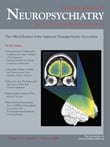To the Editor: Brain mechanism of beliefs and false beliefs remains utterly elusive. In contrast to psychiatry, where false beliefs constitute the background of mystic, cosmologic, or paranoid delusions, beliefs are seldom reported in the context of neurological disorders. A strong belief that the hemiplegic hemibody is still moving after nondominant hemispheric stroke, confabulation during Korsakoff syndrome and fluent aberrant speech production without perceiving the lack of sense during Wernicke’s aphasia are classical examples of false beliefs involving specific neurological function due to brain damage.
1 –
3 Herein, we would like to report the case of a patient suffering from severe migraine attacks during which he presented with isolated false beliefs strikingly influencing his behavior.
Case Report
A 54-year-old man had suffered from migraine since early adulthood. He had no other disease and was receiving no treatment. His migraine attacks were characterized by recurrent episodes of violent headache, nausea and vomiting, and a strong need to sleep, usually beneficial naps. The episodes lasted between 10 and 24 hours. The frequency had been diminishing over the last few years.
Last January 31st, the day after a meal with seafood and wine, the patient awoke with frontal pain, suggestive of a hangover. He left for work, as usual, but quickly returned home because of the intensity of the pain and associated nausea (he felt unable to drink his coffee and had no appetite). Once home, he slept until approximately noon. When he awoke, he was convinced that he had to go to his parents-in-law’s to look for his wife, asked his daughter-in-law to close all the shutters in the house, and went to the home of his in-laws, where, when he saw that his wife was not there, he “pretended” to look for her all over the house in a somewhat mischievous fashion. When his wife arrived at her parents’ home after having been called by her mother, he seemed a bit irritated at having made a mistake. He remembered all of the events. His behavior seems adapted to the conviction that he expressed, according to those present. The only thing that seemed unusual was his adherence to a false belief, vivid and long-lasting (while he was looking for his wife at her parent’s house, who attempted to persuade him that she was at work, as usual, he remained convinced that she in fact was in their house). After this episode, he went to bed and again spent the entire afternoon sleeping. When his wife woke him early in the evening, he suddenly quite vehemently demanded that she cook pasta, holding his mobile phone in one hand and the alarm clock in the other. The request was remarkable given the importance granted to the time (between 7 and 8 o’clock), the imperative nature of the demand, and the annex remarks (“Does the pasta look pretty?”). In recounting the episode, the patient remembered the importance he gave to the fact that “it should not change my self-biology.” His wife prepared the pasta; he ate it, vomited, and returned to bed. During the next night, close to 4.00 a.m., he suddenly awoke “obsessed by the idea of an appointment.” He quickly corrected himself and went back to sleep. The next day, he did not feel very good, but the manifestations disappeared. In recounting the events of these 20 hours, he recalled the onset of a single and isolated nighttime episode, in June 2006, where he got up close to 4.00 a.m. and set the dining room table. He remembered being convinced of an imminent family meal.
Brain CT scan, brain MRI, and prolonged EEG after a total sleep deprivation were performed and did not show any anomaly. The diagnosis of a migraine attack in a migraineur was concluded, with a recurrent false belief following each awakening during the period of the attack. This diagnosis was supported by the clinical setting, the severe frontal pain, the transient hypersomnia, and the digestive signs.
Discussion
Confusion on awakening represents a subgroup of parasomnia, possibly related to dissociated slow-wave sleep, that is, a patient with behavioral manifestations (somnambulism, sleep terror, etc.) without the EEG correlates of being awake. In contrast to this diagnosis, this patient was clearly not confused, as the witnesses reported normal behavior for the incorrect belief. In the same way, epileptic seizures were considered as a possible diagnosis, but ruled out given the lack of confusion, aphasia, memory impairment during the episodes, long duration, and normal investigations including prolonged EEG. We propose that the present patient suffered from isolated false belief during the migraine attack. A possible transient dysfunction involving the right hemisphere could be suggested, according to the theory of left (so-called “dominant”) interpretative brain,
4 the lack of language disorder during the reported attack, and the potential transient impact of migraine on brain hemispheric function.

